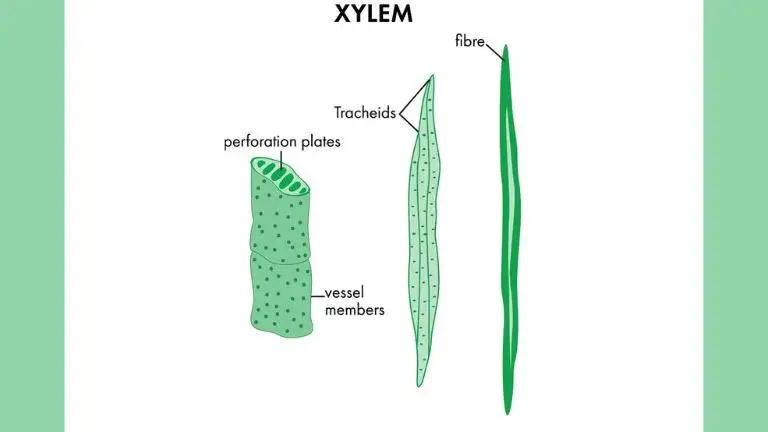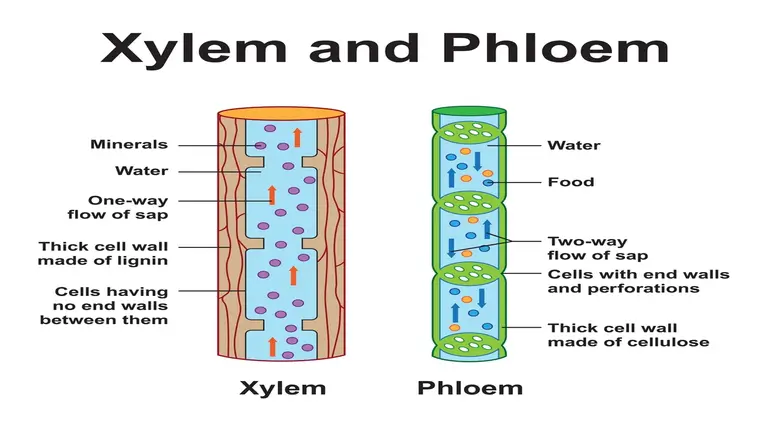Phloem and xylem are two different types of complicated permanent tissues that transport different elements throughout plants.
The difference between xylem and phloem is that the xylem transports water and other substances from the roots to the leaves in the plants.
While the phloem transports amino acids and glucose produced by photosynthesis in the leaves to the remaining parts of the plant.
Lets get started.
Table of Contents
Xylem and Phloem – Transport in Plants

Transportation of nutrients and foods occurs in plants due to the presence of the xylem and phloem.
To function effectively, every cell in the human body requires a variety of different substances. Oxygen and glucose, as an example.
However, the body’s cells cannot get these chemicals directly from outside.
Because of this, they depend on the circulatory system to transport these substances from the body parts that produce them, such as the lungs and small intestine, to all the body cells that require them.
Like in plants, essential elements like water and minerals come from the soil and are absorbed through the root, whereas glucose is made during photosynthesis in the leaf.
The substances can flow from one area of the plant to another due to the vascular tissue.
The xylem and phloem are the two primary vascular tissues in plants.
Suppose you’ve seen a tree that has fallen over and looked inside. In that case, you’ll notice that most of the heartwood and sapwood in the radial contents are xylem tissues, and the inner layer of the bark is made up of a phloem.
Definition of Xylem

The xylem is in charge of distributing the water and nutrients that the roots absorb.
The fact that some xylem components lack protoplasm or cell walls makes them fascinating since they make it easier for water and minerals to pass through.
Xylem is also known as “dead tissue” because except for the xylem parenchyma, all of the tissues in the xylem are dead.
Cell organelles are likewise absent from the xylem tissues. As a result, they are regarded as dead tissues.
An element called lignin strengthens the xylem cells. Depending on the location, lignin will have a different pattern. It might be pitted, reticulated, spiral or have rings.
Composition of Xylem
The xylem is made up of conducting cells called tracheids, vessel elements, and parenchyma.
Tracheids: Tracheids are the plants in test tube form. A network of cells connects the roots and leaves with pitted walls called tracheids, where the water does not flow continuously.
Parenchyma: The parenchyma, the only living cell in the xylem, aids in food storage, while the fiber cells mostly serve as supporting components.
Vessel elements: Additionally, the xylem has vessel elements made up of long tubes that run continuously from the roots to the leaves.
Both tracheids and vessel elements in the water’s conduction along the stem give the plant mechanical support.
Definition of Phloem

The phloem distributes produced foods like sucrose and amino acids from the green sections of the plant, such as the leaves, to other parts of the plants. Translocation is the name of this process.
The vascular tissue known as phloem is in charge of moving and distributing organic nutrients. The phloem has a structural purpose in the body of the plant and is a channel for chemical signals.
Composition of Phloem
Phloem is basically composed of four types of cells:
Parenchyma, companion cells, phloem fiber and sieve tubes make up phloem.
- Sieve Tubes: A single row of extended, thin-walled cells makes up a sieve tube. Its walls are sieve-like perforated with tiny pores, as the name would imply. A thin layer of cytoplasm that transports generated food from one cell to the next is present in mature sieve cells.
- Companion Cells: The sieve tube cell needs another protoplasm to perform its essential functions because its protoplasm has deteriorated. For this reason, a companion cell exists for a sieve tube cell.
- Phloem Fiber: The phloem fiber cell aids in providing structural support, just like in the xylem, and the parenchyma stores food and other items. The only kind of cell dead in the phloem is the fiber cell.
- Phloem Parenchyma: Phloem parenchyma’s primary purpose is to store food as well as other materials including latex, and mucilage. They support the food movement. It also gives the plant its mechanical sturdiness.
Arrangements of Xylem and Phloem Tissues
Plant tissues come in two varieties: complex tissues and simple tissues. Complex tissues include xylem and phloem tissues because they are composed of several cell types.
In diverse plant portions, the vascular tissue is arranged in various ways. Herbaceous dicot plants have an x-shaped section of xylem in the center of their roots, surrounded by a phloem.
The stem’s xylem and phloem are grouped in circular patterns.
These groups are found close to the stem’s margin. The xylem and phloem are found in the vascular bundle when in the leaf, with the xylem sitting above the phloem.
Read more: What is the Difference Between Chlorophyll and Chloroplast?
Difference Between Xylem and Phloem

Rows of cells form a continuous tube that runs the entire plant length in both the xylem and the phloem.
There are many differences between xylem and phloem given below:
- The difference between xylem and phloem is that the elongated dead cells that make up the xylem vessels have walls containing lignin and impermeable to water.
- While the living cells make up the phloem vessels. They move amino acids and sucrose up and down the plant.
- Another difference between xylem and phloem is that sucrose and amino acids move up and down the phloem while water and minerals move up the xylem.
- If we compare xylem and phloem tissues, xylem only travels one way, from the roots to the top portions of the plant. On the other hand, the phloem movement is bidirectional, which is the opposite of the xylem movement.
- Phloem comprises phloem fibers, phloem parenchyma, companion cells, and sieve tubes, while xylem comprises features like xylem fibers, xylem parenchyma, tracheids, and vessels.
What are the Differences Between Xylem and Phloem?
Highlighting the differences between xylem and phloem in the following table:
| Xylem | Phloem |
|---|---|
| Xylem transfers water and minerals from the roots to the top sections of the plant. | Phloem transports nutrients like Amino acids and sugars are transported from the leaves to the plant’s growing sections. |
| Its movement is one-way and it is found in the leaves, stems, and roots. | It moves in both directions. |
| They are star-shaped constructions with tubular shapes and no cross walls. | They are long, tubular-shaped constructions with walls made of fine sieve tubes. |
| It includes tracheid’s, xylem parenchyma, xylem sclerenchyma, and vessel elements. | It includes intermediary cells, sieve tubes, fibers, phloem parenchyma, and companion cells. |
| Xylem mainly consists of dead cells which are hollow and are found in the core of the vascular bundle. | The phloem consists of the living cells found on the vascular bundle’s periphery. |
Conclusion
Both are conducting (vascular) tissue found in Vascular plants. However, they are very different from one another.
Plants use vascular tissues called Xylem and Phloem to translocate and transport elements like water and minerals. The difference between xylem and phloem is that the inner, “dead” tube of a plant’s stem, known as the xylem, is responsible for carrying water to the leaves and other parts of the plant. It is cellulose-based.
On the other hand, a living component of the plant called the phloem surrounds the xylem and actively carries essential minerals and carbohydrates throughout the entire organism.
Read more: What is the Difference Between Oxidation and Reduction?


